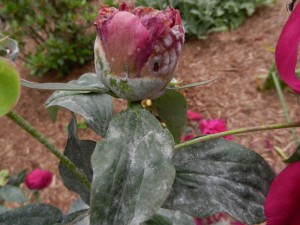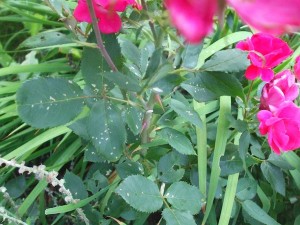
Watering large shade trees will be an important task to help them weather a third year of lwoer-than-normal rainfall. (C) Jo Ellen Meyers Sharp
What we need now, and I mean now, is for the skies to open up with the rain…a long, slow soaking rain.
Indianapolis has had only one-half inch of rain since early June. During that period, Indiana had lots of 90-degree days.
For most Hoosiers, this is year three of hot, dry conditions and more plants will reveal these stresses in their lives.

Powdery mildew was common this spring on peonies. Photo courtesy Purdue University
In a weakened condition, plants may be more susceptible to insect or disease. Peonies were hit hard with powdery mildew this spring and sawflies (sometimes called rose slugs) have been making holey messes of rose leaves.
Leaves on maples and other shade trees may be smaller this year and some ornamental trees, such as dogwoods, did not bloom, reflecting two years of lower than normal rainfall.
Gardeners need to focus more on larger, woody plants, such as trees and shrubs, which usually demand little attention. These plants are the most expensive to replace in the landscape, and they add value to real estate property. With what’s predicted to be the third year of little to no rain, they will need some TLC for their survival.

Sawfly damage on roses. (C) Jo Ellen Meyers Sharp
We hear all the time to give plants an inch of water a week. How much is that? Keep Indianapolis Beautiful Inc., says three 5-gallon buckets of water dumped at the base of small trees and shrubs once a week equals about 1-inch of water. KIB Arborist Nate Faris suggests doubling that amount during hot, dry spells.
The 1-inch can be delivered all at once or in two applications in a seven-day period.
For mature trees, a sprinkler should deliver water under the canopy to 3 to 4 feet outside the drip line. Place several straight edge cans throughout the area to be watered and when there’s an inch (or half-inch) of water, you know how much has been applied.